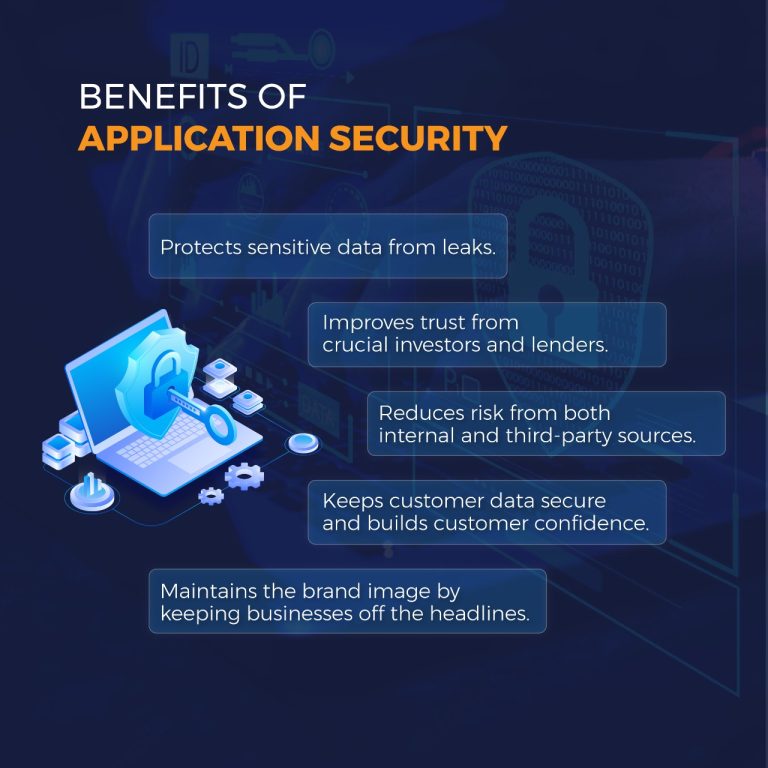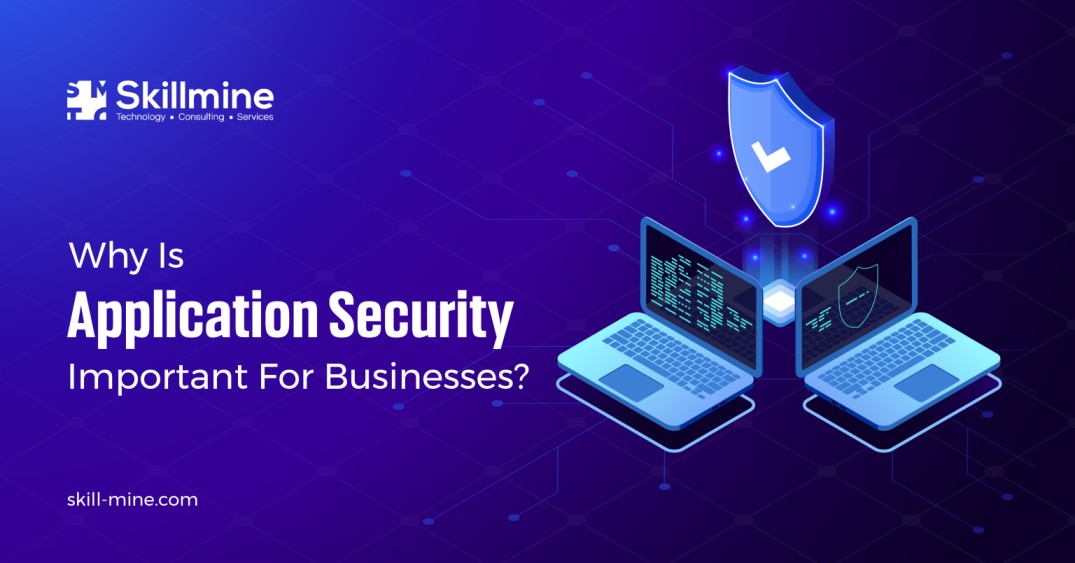Every business relies on a range of software applications- from email and your web browser to more sophisticated programmes like customer relationship management and data analytics- on a daily basis. Vulnerabilities may arise if security is not prioritised during app design, development, and configuration. With security breaches becoming more frequent, application security has become vital for businesses.
Application security includes measures to increase an application’s security by finding, fixing, and avoiding security problems. Security scanning is critical to safeguard essential data against vulnerabilities and defend against cybercrime costs. Organizations must take extreme measures to protect websites and apps because attackers these days are using application security vulnerabilities to obtain private data.
Importance of application security
Application security is essential for every business that handles customer data. Applications are often expected to guarantee the security and privacy of user data. Nevertheless, the users’ data might be at risk if an application has flaws. As a result, users may be exposed to online threats like identity theft and file loss due to this vulnerability.
The highest level of protection against cyberattacks is provided by application security. Potential weaknesses in the program’s source code can be found using application security techniques, such as routine application testing conducted before the application’s release. This will guarantee that the vulnerabilities are swiftly patched to stop new attacks.

Application Security Tools and Solutions
Application security is paramount in the ever-evolving digital landscape. A robust set of application security tools is essential to safeguard against evolving threats.
- Web Application Firewall (WAF)
A Web Application Firewall acts as a shield, monitoring and filtering HTTP traffic between web applications and the Internet. Unlike a proxy server, a WAF protects the server from exposure, defending against cross-site scripting and SQL injection threats.
- Runtime Application Self-Protection (RASP)
RASP technology analyzes user behaviour and application traffic at runtime, actively detecting and preventing cyber threats.
- Vulnerability Management
Vulnerability management tools scan applications for known vulnerabilities, classify them by severity, and prioritize mitigation based on the criticality of the issues.
- Software Bill of Materials (SBOM)
An SBOM provides transparency into software composition, listing components used in an application. It aids in tracking and managing vulnerabilities.
- Software Composition Analysis (SCA)
SCA tools create inventories of third-party components within software products, helping identify actively used components and severe security vulnerabilities affecting them.
- Static Application Security Testing (SAST)
SAST tools assist white box testers by inspecting static source code identifying security weaknesses, including syntax errors and input validation issues.
- Dynamic Application Security Testing (DAST)
For black box testing, DAST tools execute and inspect code at runtime, identifying security vulnerabilities through large-scale scans simulating malicious test cases.
- Interactive Application Security Testing (IAST)
IAST tools combine SAST and DAST techniques to dynamically inspect software during runtime, offering insights into the root causes of vulnerabilities and specific lines of affected code.
- Mobile Application Security Testing (MAST)
MAST tools employ static and dynamic analysis techniques to test the security of mobile applications, addressing issues such as jailbreaking and data leakage.
- Cloud Native Application Protection Platform (CNAPP)
A CNAPP is a centralized control panel that unifies cloud workload protection and security posture management. It often includes identity entitlement management, API discovery and protection, and automation and orchestration security for container orchestration platforms.
Common vulnerabilities that result from poor application security
Ineffective Access Control
A system’s permissions are disregarded by an attacker when there is broken access control. If the access control does not uphold the security policy, an attacker may access restricted data that they are not permitted to access. They can even add, remove, and modify this data.
Failures in Cryptography
The study of secure communication methods, such as encryption, in which only the sender and recipient of a message can see the message’s content, is known as cryptography. A cryptographic failure happens when a weak encryption (i.e., cryptographic) algorithm allows an attacker to access sensitive data.
Injection
Your application could be attacked with malicious code injection, which could cause the interpreter to issue unauthorised commands. Applications that lack a reliable filter to identify malicious data or a method to check user-provided data are susceptible to injection attacks.
Insecure design
An application is said to have an insecure design when a developer concentrates on the design and architecture without incorporating security safeguards. This may occur when a developer is unaware of the degree of security needed for their application.
Failures in authentication and identification
Almost all apps demand some kind of identity verification from their users. Your system is exposed if you do not include authentication in your online application.
Best Practices to Ensure Application Security
Secure Your Software Development Life Cycle (SDLC)
The Software Development Life Cycle (SDLC) encompasses various stages such as design, implementation, testing, deployment, and maintenance. Integrating application security measures throughout each phase of the SDLC significantly reduces the risk of attacks after deployment. Early detection and mitigation of vulnerabilities during the SDLC are more cost-effective and easier to manage.
Organizations should conduct regular security reviews and use automated security testing to proactively identify and address vulnerabilities. Adopting a DevSecOps approach, which incorporates security measures like risk assessments, threat modeling, and security controls, is crucial.
Adopt the Principle of Least Privilege (PoLP)
Implementing PoLP helps limit the potential impact of compromised accounts and reduces the risk of unauthorized data access. To adopt PoLP, assess the tasks that need to be performed and assign the minimum necessary permissions. Regularly review permissions to prevent access rights from expanding unintentionally and to remove permissions that are no longer needed. PoLP reduces the attack surface, makes it easier to detect suspicious activity, and minimizes the damage from security incidents.
Secure Data Storage and Transmission
To protect against data breaches, ensure secure storage and transmission of data. This involves implementing encryption for data at rest and in transit, using strong encryption algorithms, and managing keys properly. Techniques like tokenization can replace sensitive data with tokens to make it difficult for attackers to decipher. Secure data storage and transmission protect sensitive data from unauthorized access or tampering and help comply with regulations like GDPR and HIPAA.
Leverage Monitoring and Observability
To maintain security, gain visibility into application behavior and detect anomalies through comprehensive logging and monitoring strategies using observability tools. Centralize logs from all application components and instrument applications to capture key metrics. Automated systems should continuously monitor logs and metrics, with alerts for incident detection.
Perform Regular Security Testing and Auditing
Regular security testing helps maintain a robust security posture by identifying and addressing vulnerabilities proactively. This includes penetration testing, automated security scanning, and code reviews. Regular testing ensures applications remain resistant to evolving threats.
Establish an Incident Response Plan
A comprehensive Incident Response (IR) plan is essential for effectively responding to security incidents. An IR plan outlines roles, communication channels, and processes for identifying, containing, and remediating incidents. Regularly review and update the plan to ensure its relevance.
Implement Security Awareness Training
Security awareness training educates employees on recognizing and avoiding security threats, reducing the risk of phishing and social engineering attacks. Regularly update training content to address new and ongoing threats.
By adopting these best practices, organizations can significantly improve their security posture, thereby reaping the benefits of application security.
Conclusion
Security should never be neglected after the completion of application development. Ensure that every member of your application development team is highly aware and knowledgeable about application security. Early vulnerability detection can lower the likelihood of an attacker accessing your application. Skillmine’s application security services follow the best practices to safeguard your business applications.
Looking for expert technology consulting services? Contact us today.










